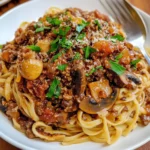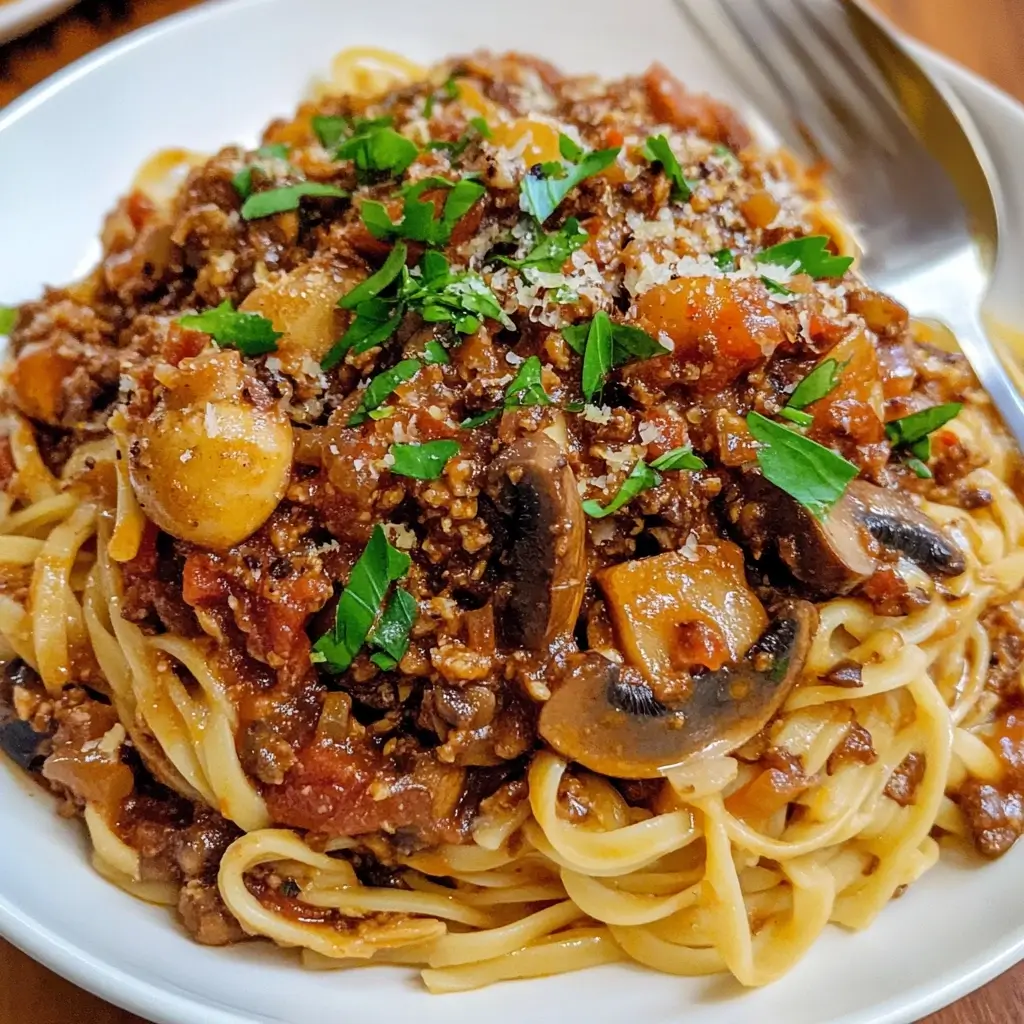This Vegetarian Mushroom Ragu has become an absolute staple in our household, a dish that even the most devoted meat-eaters in my family now request with surprising frequency. I remember the first time I made it; I was a little skeptical. Could mushrooms really replicate that deep, savory, comforting richness of a traditional meat ragu? The answer, I discovered, was a resounding YES. The aroma alone, as it simmered away on the stove – a complex medley of earthy mushrooms, sweet tomatoes, fragrant herbs, and a hint of red wine – had everyone drifting into the kitchen, noses twitching. When we finally sat down to eat, spooning generous ladlefuls over steaming pappardelle, there was a moment of stunned silence, followed by appreciative murmurs that quickly turned into enthusiastic praise. It’s hearty, deeply flavorful, and has a wonderfully satisfying texture that clings perfectly to pasta. It’s the kind of meal that feels both rustic and elegant, perfect for a cozy weeknight dinner or for impressing guests. Since then, it’s been my go-to for a comforting, plant-based meal that never fails to deliver.
The Ultimate Vegetarian Mushroom Ragu: A Deep Dive into Rich, Savory Flavors
Welcome to a recipe that will redefine your understanding of vegetarian comfort food. This Vegetarian Mushroom Ragu is not just a substitute for its meaty counterpart; it’s a culinary masterpiece in its own right. Packed with umami-rich mushrooms, aromatic vegetables, and a luscious tomato base, this ragu simmers to perfection, creating a sauce that is both hearty and sophisticated. Whether you’re a lifelong vegetarian, looking to incorporate more plant-based meals, or simply a lover of good food, this mushroom ragu is guaranteed to become a favorite. It’s a versatile sauce that pairs beautifully with various starches, making it a true kitchen hero.
Why You’ll Fall in Love with This Vegetarian Mushroom Ragu
Before we delve into the nitty-gritty of the recipe, let’s talk about why this particular mushroom ragu stands out:
- Incredible Depth of Flavor: A carefully selected blend of mushrooms, slow-cooked aromatics, red wine, and quality tomatoes creates layers of complex, savory notes that rival any meat-based sauce.
- Satisfyingly “Meaty” Texture: The combination of different mushroom varieties, when properly cooked, yields a wonderfully robust and chewy texture that mimics the heartiness of traditional ragu.
- Surprisingly Easy to Make: While it tastes like it simmered for days, the active preparation time is manageable, and the slow simmer does most of the work for you.
- Healthy & Wholesome: Packed with vegetables and mushrooms, this ragu is a nutritious powerhouse, rich in vitamins, minerals, and fiber.
- Incredibly Versatile: Perfect over pasta, polenta, gnocchi, or even as a filling for lasagna or shepherd’s pie.
- Crowd-Pleaser: This dish is a guaranteed hit with vegetarians and meat-eaters alike. It’s elegant enough for a dinner party yet comforting enough for a weeknight family meal.
Ingredients: The Building Blocks of Flavor
The key to a truly exceptional mushroom ragu lies in the quality and variety of its ingredients. Each component plays a crucial role in building the rich, complex flavor profile we’re aiming for.
- For the Mushrooms (The Stars of the Show):
- Dried Porcini Mushrooms: 1 oz (approx. 30g) – These are non-negotiable for intense, earthy umami.
- Hot Water: 1.5 cups – For rehydrating the porcini.
- Cremini Mushrooms: 1 lb (approx. 450g), roughly chopped – Provide a good base flavor and meaty texture.
- Shiitake Mushrooms: 8 oz (approx. 225g), stems removed, caps roughly chopped – Offer a deeper, smokier flavor.
- Oyster Mushrooms (Optional but Recommended): 8 oz (approx. 225g), torn or roughly chopped – Add a delicate, slightly seafood-like note and a tender-chewy texture.
- For the Aromatic Base (The Soffritto):
- Extra Virgin Olive Oil: 3-4 tablespoons
- Yellow Onion: 1 large, finely chopped
- Carrots: 2 medium, finely chopped
- Celery Stalks: 2 medium, finely chopped
- Garlic: 4-6 cloves, minced
- For the Sauce & Flavor Enhancers:
- Tomato Paste: 2 tablespoons – Adds concentrated tomato flavor and depth.
- Dry Red Wine: 1 cup (e.g., Cabernet Sauvignon, Merlot, Chianti) – For deglazing and adding complexity. (Can substitute with extra vegetable broth if avoiding alcohol).
- Crushed San Marzano Tomatoes: 1 large can (28 oz / 794g) – Quality tomatoes make a huge difference.
- Vegetable Broth: 1 cup (plus more if needed, including the reserved porcini soaking liquid).
- Soy Sauce or Tamari: 1-2 tablespoons – Another umami booster.
- Balsamic Vinegar: 1 teaspoon – Adds a touch of sweetness and acidity at the end.
- Fresh Thyme Sprigs: 2-3 sprigs (or 1 teaspoon dried thyme)
- Fresh Rosemary Sprig: 1 small sprig (or 1/2 teaspoon dried rosemary, crushed)
- Bay Leaf: 1-2
- Salt: To taste (start with 1 teaspoon)
- Freshly Ground Black Pepper: To taste (start with 1/2 teaspoon)
- Red Pepper Flakes (Optional): 1/4 – 1/2 teaspoon, for a touch of heat.
- For Finishing (Optional but Recommended):
- Fresh Parsley: 1/4 cup, chopped – For brightness.
- Fresh Basil: A few leaves, torn – For aroma.
- Nutritional Yeast (for vegan “parmesan” flavor): 1-2 tablespoons, stirred in at the end, or for sprinkling.
- Plant-Based Cream or Full-Fat Coconut Milk (canned, thick part only): 2-3 tablespoons, for extra richness (optional).
- High-Quality Extra Virgin Olive Oil: For drizzling.
Instructions: Crafting Your Masterpiece Step-by-Step
Patience is key when making a good ragu. Allow the flavors to meld and develop through each stage of cooking.
- Rehydrate Porcini & Prepare Mushroom Base:
- Place the dried porcini mushrooms in a heatproof bowl. Pour 1.5 cups of hot (not boiling) water over them. Let them soak for at least 20-30 minutes until softened.
- Once softened, carefully lift the porcini from the soaking liquid, squeezing out any excess water back into the bowl. Roughly chop the rehydrated porcini.
- Strain the soaking liquid through a fine-mesh sieve lined with a coffee filter or paper towel to remove any grit. Reserve this precious, flavorful liquid. You should have about 1 cup.
- Sauté the Fresh Mushrooms:
- Heat 1-2 tablespoons of olive oil in a large, heavy-bottomed pot or Dutch oven over medium-high heat.
- Add the fresh mushrooms (cremini, shiitake, oyster) in batches, being careful not to overcrowd the pan. Cook each batch for 5-7 minutes, stirring occasionally, until they are nicely browned and have released their moisture. Season lightly with salt and pepper.
- Remove the browned mushrooms from the pot and set them aside. This browning step is crucial for developing deep flavor.
- Build the Aromatic Base (Soffritto):
- Add the remaining 1-2 tablespoons of olive oil to the same pot over medium heat.
- Add the finely chopped onion, carrots, and celery. Sauté for 8-10 minutes, stirring occasionally, until the vegetables are softened and translucent. Do not rush this step; it builds a foundational layer of sweetness and flavor.
- Add the minced garlic and optional red pepper flakes. Cook for another 1-2 minutes until fragrant, being careful not to burn the garlic.
- Deepen Flavors & Deglaze:
- Stir in the tomato paste and cook for 2-3 minutes, stirring constantly, until it darkens slightly. This “toasts” the paste and enhances its flavor.
- Add the chopped rehydrated porcini mushrooms to the pot and stir for a minute.
- Pour in the red wine to deglaze the pan, scraping up any browned bits from the bottom of the pot with a wooden spoon. Let the wine simmer and reduce by about half, about 3-5 minutes.
- Simmer to Perfection:
- Add the crushed San Marzano tomatoes, the reserved porcini soaking liquid, 1 cup of vegetable broth, soy sauce/tamari, thyme sprigs, rosemary sprig, and bay leaf. Stir well to combine.
- Bring the sauce to a gentle simmer. Once simmering, return the sautéed fresh mushrooms to the pot.
- Season with 1 teaspoon of salt and 1/2 teaspoon of black pepper. Stir, taste, and adjust seasoning if needed, but remember flavors will concentrate as it simmers.
- Reduce the heat to low, cover the pot partially (leaving a small gap for steam to escape), and let the ragu simmer gently for at least 1 hour, or preferably 1.5 – 2 hours. Stir occasionally to prevent sticking and add more vegetable broth or water if the sauce becomes too thick. The longer it simmers, the more the flavors will meld and deepen.
- Finish and Adjust:
- After the simmering time, remove the thyme sprigs, rosemary sprig, and bay leaves.
- Stir in the balsamic vinegar. Taste the ragu and adjust seasonings (salt, pepper) as needed. If you want it richer, stir in the optional plant-based cream or nutritional yeast now.
- If the sauce is too thin for your liking, you can simmer it uncovered for a bit longer to reduce. If it’s too thick, add a splash more broth or water.
- Stir in most of the chopped fresh parsley and basil, reserving some for garnish.
Nutrition Facts
- Servings: This recipe yields approximately 6-8 generous servings of ragu.
- Calories per Serving (approximate, sauce only): Around 200-250 calories per serving, depending on the exact ingredients used (especially oil quantity) and serving size. This does not include pasta or other accompaniments.
- Disclaimer: Nutritional information is an estimate and can vary based on specific ingredients, brands, and portion sizes. For precise figures, use a nutritional calculator with your exact ingredients.
Preparation & Cooking Time
- Preparation Time: 30-40 minutes (includes chopping vegetables and mushrooms, rehydrating porcini)
- Cooking Time: 1 hour 30 minutes to 2 hours 30 minutes (includes sautéing mushrooms and aromatics, and the crucial simmering time)
- Total Time: Approximately 2 hours to 3 hours 10 minutes
While it requires some patience for simmering, much of this is hands-off time, allowing the magic to happen on the stovetop.
How to Serve Your Vegetarian Mushroom Ragu
This versatile ragu is a delight served in numerous ways. Here are some classic and creative ideas:
- With Pasta (The Classic Choice):
- Pappardelle: Wide, flat ribbons are traditional for ragu and catch the sauce beautifully.
- Tagliatelle: Similar to pappardelle but slightly narrower.
- Rigatoni or Penne: Tube shapes with ridges are excellent for holding the chunky sauce.
- Gnocchi: Soft potato dumplings are a heavenly pairing.
- Whole Wheat or Gluten-Free Pasta: Choose your favorite to suit dietary needs.
- Serving Tip: Always toss the cooked pasta with a portion of the ragu in the pot before serving, ensuring every strand is coated. Serve with an extra ladleful on top.
- Over Creamy Polenta:
- The soft, comforting texture of polenta is a perfect foil for the rich ragu.
- Consider making a cheesy polenta (using nutritional yeast for a vegan version) for extra indulgence.
- With Crusty Bread:
- Serve a generous bowl of ragu with warm, crusty artisan bread for dipping and mopping up every last bit of sauce.
- As a Lasagna Filling:
- Layer this mushroom ragu with lasagna sheets, béchamel sauce (plant-based if desired), and vegan or dairy cheese for an incredibly rich vegetarian lasagna.
- As a Topping for Baked Potatoes or Sweet Potatoes:
- A hearty and nutritious meal option.
- Over Cooked Grains:
- Try it with farro, barley, or quinoa for a wholesome and textured meal.
- Garnishes:
- Always finish with a sprinkle of fresh chopped parsley or basil.
- A drizzle of high-quality extra virgin olive oil.
- A grating of Parmesan cheese (or vegan Parmesan alternative/nutritional yeast).
- A pinch of red pepper flakes for those who like extra heat.
Additional Tips for Ragu Perfection
- Mushroom Variety is Key: Don’t skimp on using different types of mushrooms. Each brings a unique flavor and texture. If you can find them, wild mushrooms like chanterelles or morels would be an exquisite (though pricier) addition.
- Brown Your Mushrooms Properly: This is crucial for developing deep, savory, umami flavors. Sauté them in batches so they brown rather than steam. Don’t rush this step!
- The Power of Porcini Liquid: The soaking liquid from dried porcini mushrooms is liquid gold. It’s packed with intense mushroom flavor. Always strain it carefully to remove grit before adding to your sauce.
- Low and Slow Simmer: Patience is a virtue with ragu. A long, slow simmer (at least 1 hour, preferably 1.5-2) allows all the flavors to meld together, deepen, and create a truly harmonious sauce. The texture also improves significantly.
- Taste and Adjust Seasoning at the End: Flavors concentrate and change during simmering. Wait until the end to do your final seasoning adjustments. A little more salt, a touch of balsamic for acidity, or a pinch more herbs can make all the difference.
FAQ: Your Vegetarian Mushroom Ragu Questions Answered
- Q1: Can I make this mushroom ragu vegan?
- A: Absolutely! This recipe is very easily made vegan. Simply ensure your red wine is vegan-certified (many are, check Barnivore.com), use tamari instead of soy sauce if you prefer (though many soy sauces are vegan), and if you opt for any creamy additions, use plant-based cream (like cashew or oat cream) or the thick part of canned coconut milk. For a “cheesy” element, nutritional yeast is fantastic.
- Q2: Can I make this gluten-free?
- A: Yes, the ragu itself is naturally gluten-free. Just make sure your soy sauce is tamari (which is typically gluten-free, but always check labels) and serve it with gluten-free pasta, polenta, rice, or other gluten-free grains.
- Q3: What if I don’t want to use red wine?
- A: While red wine adds significant depth, you can substitute it with an equal amount of extra vegetable broth, perhaps with an added teaspoon of balsamic vinegar or a splash of red wine vinegar mixed into the broth to mimic some of the acidity and complexity. You could also try a good quality non-alcoholic red wine.
- Q4: How long will this ragu last, and can I freeze it?
- A: This mushroom ragu stores wonderfully. Keep it in an airtight container in the refrigerator for up to 4-5 days. It often tastes even better the next day! For freezing, let it cool completely, then transfer to freezer-safe containers or bags. It will keep well in the freezer for up to 3 months. Thaw overnight in the refrigerator and reheat gently on the stove, adding a splash of water or broth if needed.
- Q5: I’m not a huge fan of a specific mushroom type listed. Can I substitute?
- A: Yes, you can. While the blend is designed for optimal flavor and texture, feel free to adjust based on preference or availability. If you don’t like shiitakes, for example, you can use more cremini or try portobello mushrooms (though they can sometimes make the sauce darker). The key is to maintain a good total quantity of mushrooms. However, I highly recommend keeping the dried porcini, as they are foundational to the umami depth.
This Vegetarian Mushroom Ragu is more than just a recipe; it’s an experience. It’s a testament to how plant-based ingredients can create dishes that are profoundly satisfying, deeply flavorful, and universally appealing. Enjoy the process of making it, the incredible aromas that will fill your kitchen, and most importantly, the delicious meal you’ll share. Happy cooking!
Print
Vegetarian Mushroom Ragu Recipe
Ingredients
- For the Mushrooms (The Stars of the Show):
- Dried Porcini Mushrooms: 1 oz (approx. 30g) – These are non-negotiable for intense, earthy umami.
- Hot Water: 1.5 cups – For rehydrating the porcini.
- Cremini Mushrooms: 1 lb (approx. 450g), roughly chopped – Provide a good base flavor and meaty texture.
- Shiitake Mushrooms: 8 oz (approx. 225g), stems removed, caps roughly chopped – Offer a deeper, smokier flavor.
- Oyster Mushrooms (Optional but Recommended): 8 oz (approx. 225g), torn or roughly chopped – Add a delicate, slightly seafood-like note and a tender-chewy texture.
- For the Aromatic Base (The Soffritto):
- Extra Virgin Olive Oil: 3-4 tablespoons
- Yellow Onion: 1 large, finely chopped
- Carrots: 2 medium, finely chopped
- Celery Stalks: 2 medium, finely chopped
- Garlic: 4-6 cloves, minced
- For the Sauce & Flavor Enhancers:
- Tomato Paste: 2 tablespoons – Adds concentrated tomato flavor and depth.
- Dry Red Wine: 1 cup (e.g., Cabernet Sauvignon, Merlot, Chianti) – For deglazing and adding complexity. (Can substitute with extra vegetable broth if avoiding alcohol).
- Crushed San Marzano Tomatoes: 1 large can (28 oz / 794g) – Quality tomatoes make a huge difference.
- Vegetable Broth: 1 cup (plus more if needed, including the reserved porcini soaking liquid).
- Soy Sauce or Tamari: 1-2 tablespoons – Another umami booster.
- Balsamic Vinegar: 1 teaspoon – Adds a touch of sweetness and acidity at the end.
- Fresh Thyme Sprigs: 2-3 sprigs (or 1 teaspoon dried thyme)
- Fresh Rosemary Sprig: 1 small sprig (or 1/2 teaspoon dried rosemary, crushed)
- Bay Leaf: 1-2
- Salt: To taste (start with 1 teaspoon)
- Freshly Ground Black Pepper: To taste (start with 1/2 teaspoon)
- Red Pepper Flakes (Optional): 1/4 – 1/2 teaspoon, for a touch of heat.
- For Finishing (Optional but Recommended):
- Fresh Parsley: 1/4 cup, chopped – For brightness.
- Fresh Basil: A few leaves, torn – For aroma.
- Nutritional Yeast (for vegan “parmesan” flavor): 1-2 tablespoons, stirred in at the end, or for sprinkling.
- Plant-Based Cream or Full-Fat Coconut Milk (canned, thick part only): 2-3 tablespoons, for extra richness (optional).
- High-Quality Extra Virgin Olive Oil: For drizzling.
Instructions
- Rehydrate Porcini & Prepare Mushroom Base:
- Place the dried porcini mushrooms in a heatproof bowl. Pour 1.5 cups of hot (not boiling) water over them. Let them soak for at least 20-30 minutes until softened.
- Once softened, carefully lift the porcini from the soaking liquid, squeezing out any excess water back into the bowl. Roughly chop the rehydrated porcini.
- Strain the soaking liquid through a fine-mesh sieve lined with a coffee filter or paper towel to remove any grit. Reserve this precious, flavorful liquid. You should have about 1 cup.
- Sauté the Fresh Mushrooms:
- Heat 1-2 tablespoons of olive oil in a large, heavy-bottomed pot or Dutch oven over medium-high heat.
- Add the fresh mushrooms (cremini, shiitake, oyster) in batches, being careful not to overcrowd the pan. Cook each batch for 5-7 minutes, stirring occasionally, until they are nicely browned and have released their moisture. Season lightly with salt and pepper.
- Remove the browned mushrooms from the pot and set them aside. This browning step is crucial for developing deep flavor.
- Build the Aromatic Base (Soffritto):
- Add the remaining 1-2 tablespoons of olive oil to the same pot over medium heat.
- Add the finely chopped onion, carrots, and celery. Sauté for 8-10 minutes, stirring occasionally, until the vegetables are softened and translucent. Do not rush this step; it builds a foundational layer of sweetness and flavor.
- Add the minced garlic and optional red pepper flakes. Cook for another 1-2 minutes until fragrant, being careful not to burn the garlic.
- Deepen Flavors & Deglaze:
- Stir in the tomato paste and cook for 2-3 minutes, stirring constantly, until it darkens slightly. This “toasts” the paste and enhances its flavor.
- Add the chopped rehydrated porcini mushrooms to the pot and stir for a minute.
- Pour in the red wine to deglaze the pan, scraping up any browned bits from the bottom of the pot with a wooden spoon. Let the wine simmer and reduce by about half, about 3-5 minutes.
- Simmer to Perfection:
- Add the crushed San Marzano tomatoes, the reserved porcini soaking liquid, 1 cup of vegetable broth, soy sauce/tamari, thyme sprigs, rosemary sprig, and bay leaf. Stir well to combine.
- Bring the sauce to a gentle simmer. Once simmering, return the sautéed fresh mushrooms to the pot.
- Season with 1 teaspoon of salt and 1/2 teaspoon of black pepper. Stir, taste, and adjust seasoning if needed, but remember flavors will concentrate as it simmers.
- Reduce the heat to low, cover the pot partially (leaving a small gap for steam to escape), and let the ragu simmer gently for at least 1 hour, or preferably 1.5 – 2 hours. Stir occasionally to prevent sticking and add more vegetable broth or water if the sauce becomes too thick. The longer it simmers, the more the flavors will meld and deepen.
- Finish and Adjust:
- After the simmering time, remove the thyme sprigs, rosemary sprig, and bay leaves.
- Stir in the balsamic vinegar. Taste the ragu and adjust seasonings (salt, pepper) as needed. If you want it richer, stir in the optional plant-based cream or nutritional yeast now.
- If the sauce is too thin for your liking, you can simmer it uncovered for a bit longer to reduce. If it’s too thick, add a splash more broth or water.
- Stir in most of the chopped fresh parsley and basil, reserving some for garnish.
Nutrition
- Serving Size: One Normal Portion
- Calories: 200-250





